Serengeti National Park I.
Serengeti National Park I.
As we proceeded onward, our driver sped past a Kite, the most massive
of the flying birds. We noted that we would like to stop for such
creatures and he was really great after that. We did get to watch it
take off and that was something. Unfortunately, not something caught
on film! The land was now very flat and we passed antelope of many
varieties, including the ubiquitous Thompson's gazelles, obvious by
the black stripe and white bellies as well as their small size.
It was in this region that we began to see large numbers of Grant's
gazelles, as well as Impala and Thompson's gazelles. Also in evidence
were a large number of ostriches.
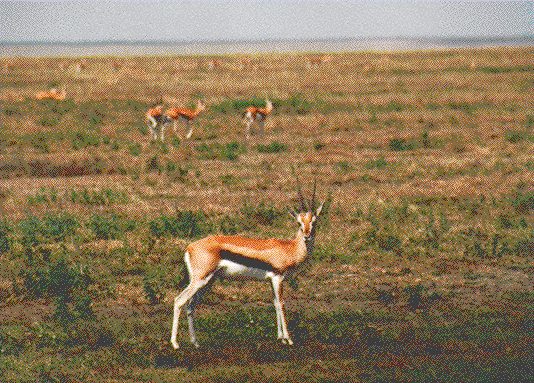
These Thompson's gazelles are everywhere in
Kenya and are the staple food for a lot of carnivores. They are among
the smallest of the gazelles and easily recognizable by the three
tones of brown, black and white seen here.
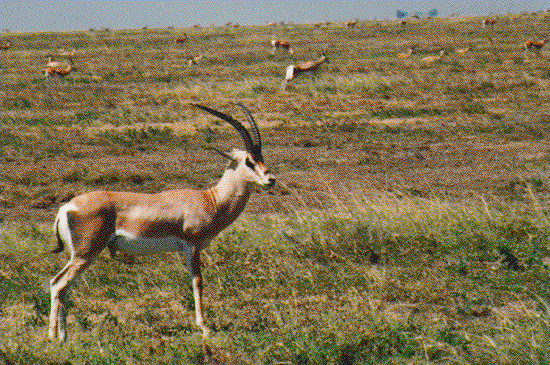
In the
Serengeti we started to see a lot of these larger gazelles, Grant's
gazelle. The black stripe of the Thompson's gazelle is absent.
About 200 yards before reaching a station within Serengeti National
Park (store; rest stop, etc.), we encountered a lion and lionness
lounging under a tree. Nearby, there was a group of cubs relaxing
under their own tree. We figured we were seeing part of a pride,
relaxing in the heat of the afternoon sun.

At
the rest stop, I was able to get a good shot of this Rainbow Starling.
Like Starlings here, these birds are prolific and hang around people,
I think. They are more colourful than the versions we have in Canada
though. Check out the needles on the Acacia tree!
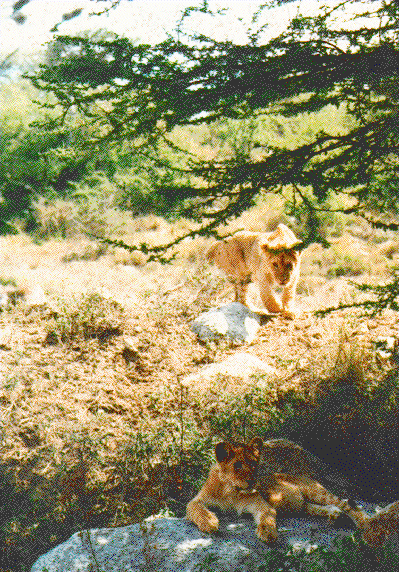
Here are the lion cubs, of which there were three. One is lounging in
the shade here as a sibling comes to join it.
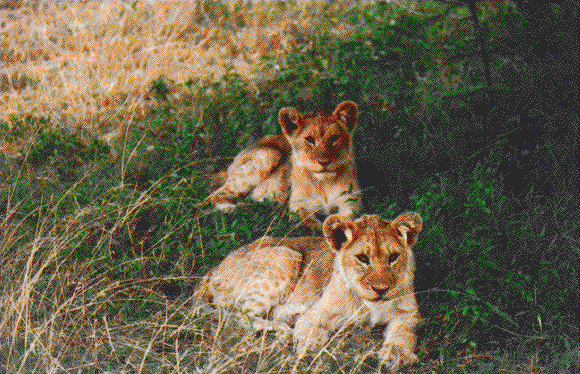
Here are two different cubs (belonging to another female we decided)
resting in the grass. Note the spots evident on theh thighs of these
cubs. They disappear after about a year or so.
Once we ventured further into the park, we saw more lions and also a
lot of baboons. Baboons appear to travel around in groups of 12 or
more.
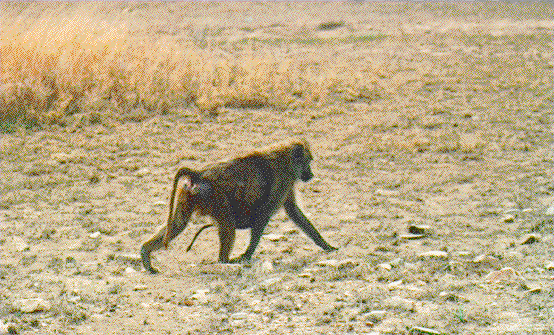
This mother is carrying her baby on her tummy. You can see the baby's
tail between the mother's hind legs.
Ballooning over the Serengeti
From the "Have you completely lost your mind?" department, I decided
to go for the ballooning safari the following morning. There were
four of us who decided to spend the 200 pounds sterling for the
opportunity to go sailing over the savanna! We had to get up at 4:30
(I think) at which time the Milky Way was overhead and looked
absolutely spectacular! Oh, to have had a tripod (I would remedy this
oversight in Hawaii the following May).
We were picked up at the campsite by a vehicle sent from the lodge
which runs the ballooning and were taken to the launch site
pre-dawn. This was the only day I was able to watch the sun rise in
Africa, since I wasn't often brave enough to venture out of the tent
at 5 am by myself.
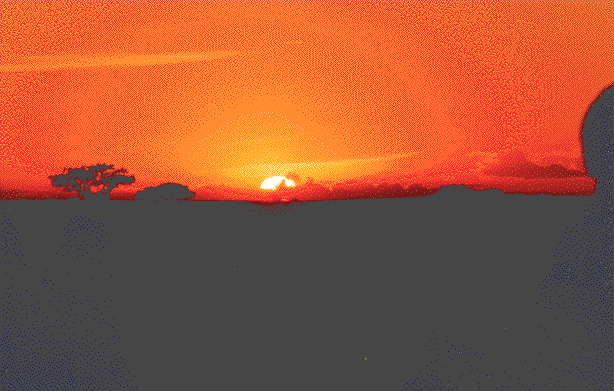
Once
we reached the launching site, the sun was on the rise and I took this
picture, which was the one good one that I got the entire time I was
there, The sun just always seemed to be up once we got up. Too bad
about the head at the right (at least I think it's a head).
Just after the sun rose, we were airborne. Taking off was an
interesting experience. Since the balloon lies sideways on the
ground, everyone has to pile in sideways and crouch down, holding
handgrips for support. Once airborne, we were able to unpack the
camera gear and begin photographing the scenery. We immediately came
upon a lionness and her cub scrambling through the grass.
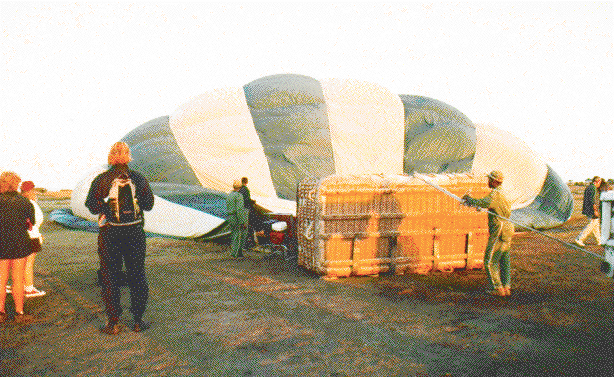
This shot was taken before we all piled in. The crew are filling the
balloon. We even had a camera crew filming the flight, I think for
some promotional video.
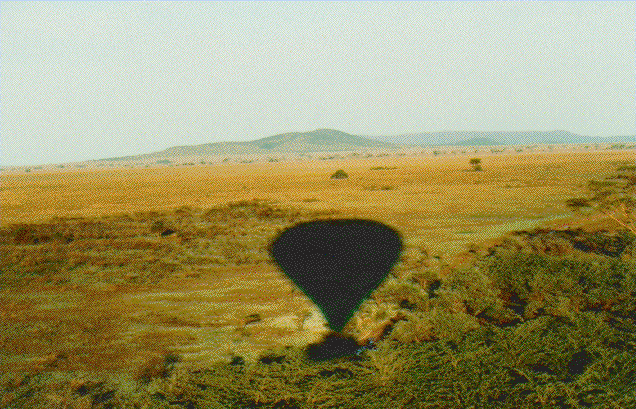
The
most amazing pictures were the ones in which the shadow of our balloon
was visible on the ground. The dense vegetation in the foreground runs
along the river.
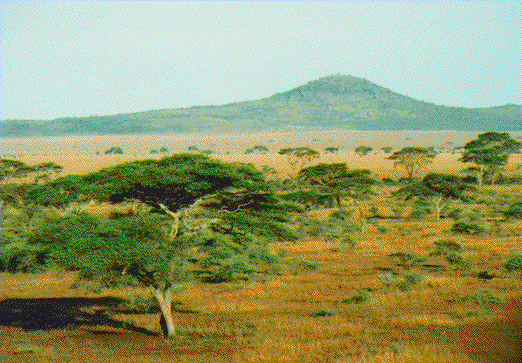
Here is another shot of the scenery. The Acacia trees are clearly
everywhere, although there are vast stretches of the savanna where
there is no cover but grass.
Unfortunately, we didn't see any leopards in the treetops as we passed
over them, but we did pass a hippo pool as well as wildebeest (called
gnus in Tanzania) and hyena. Also visible were the migratory tracks
carved out by the large herds of gnus and zebras which pass through
the crater en route from Kenya to the Serengeti and then north
again.
As we came in for a landing, we could see a huge herd of gnu ahead as
little black dots on the hill side. We then had to pack up the gear
again and then resume the sideways positions for the landing. The
balloon lands and breaks by scraping along the ground sideways. Our
pilot assured us that the landing was a gentle one.
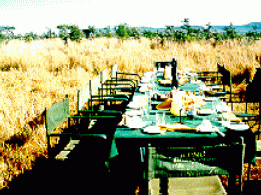
Following the ballooning, we had a champagne toast before moving on to
the breakfast spread which had been laid out for us on the savanna.
This was a delicious meal amid the high grasses of the Serengeti.
Return to Table of Contents
Forward to "Serengeti National Park II."










